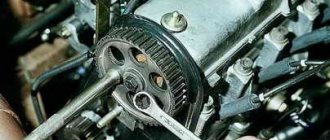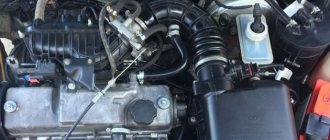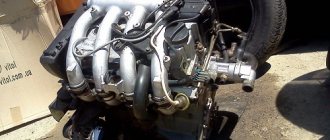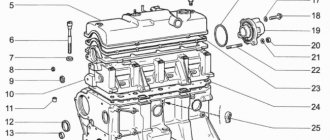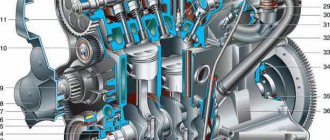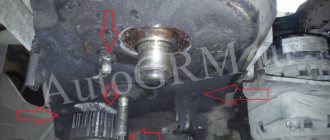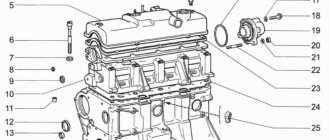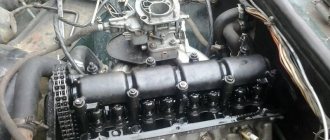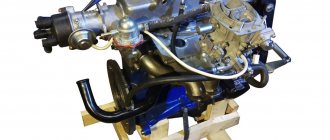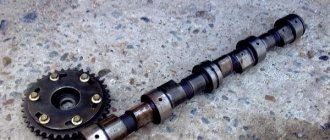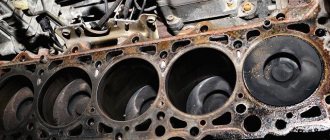We will talk about the sore point and, so to speak, about the budgetary increase in power. As you know, 70% (pelvis drivers) push the camshaft into themselves and complain about the dynamics of the car. Why did the idle disappear and the car became dumber during acceleration (when he set the roller with a phase above 270). The answer is simple, gentlemen: your shaft is not unable to work at the bottom, it works at the top. Yes, this is a very necessary thing, but for combat vehicles operating mainly at high speeds.
For an everyday car, the city mode on such a shaft will be the most severe torment, idle is about 1200-1400 rpm, respectively, you start at almost 2000 rpm, burn the clutch and, accordingly, load the standard parts of the unit, which are not designed for such a load. In the summer, the temperature in the car constantly rises and the car often boils, and it’s good if everything gets by with just a loss of antifreeze. By inserting a part without a special understanding of the characteristics of the camshaft, we can lose not only money, but also possibly end up on the capital of the cylinder head. But we will try to avoid this with you, choose the optimal shaft that really suits your riding style. But. Remember. When installing this or that shaft, you lose something. For example, let’s consider the Nuzhdin 10.93 shaft, which is very well known to you. (Please note that I once went to an online store, looked at this shaft with a phase of 282° and in it it was in the lower section (8-valve engine), although if you know a little about the camshaft, then with a phase wider than 270° it is considered upper. How? It will remain a mystery.) Therefore, it is still worth knowing what you are taking. So, let's continue. Most people install it, and its operating range is not from 2000 rpm to 5000, its range is much higher, it begins to work intensively from 3000 to 6500 rpm. In principle, it is not bad at low end, but a smoother idle speed can be achieved around 1300 rpm. Although some manage to set it to 1100 rpm. The valve travel is quite significant - 2.1 mm; if the valve belt breaks, it will definitely bend (if the engine is 1.5). So, let's try to choose the optimal camshaft for you. For city driving, as everyone knows, you need smooth idle and traction from below (increasing engine displacement will also add traction from below, but that’s another story). Let's consider them: there are three types: ➤ grassroots ➤ instant ➤ horse
Camshaft selection
Today we’ll talk about camshafts and how to match them to your needs.
When choosing a camshaft for their vehicle, people are faced with the task of selecting the right camshaft for their application. When trying to select a camshaft, they begin to study forums where there is a lot of information about which shafts were installed by whom, in what configuration and how the car drove after all this. The main parameters that appear on the forums are lift, phase and manufacturer. Moreover, some people put the camshaft phase at the forefront and practically pray for this parameter. Quite often on forums you can find phrases: my shaft is wider, which means it will trample better than yours, your phase is a pitiful 262, not like mine is 306! So let's try to understand the parameters of camshafts. The declared phase (also advertised) (264 272 276 306) indicates the maximum duration of the phase in degrees of crankshaft rotation, declared by the camshaft manufacturer; it is measured from the moment the valve begins to lift off the seat until it is completely lowered onto the seat. In real life, this parameter is quite arbitrary; the problem lies in the fact that the first millimeter of lifting and lowering is implemented smoothly so that there is no impact on the seat; it is done to reduce the load on the entire valve lifting mechanism, the camshaft itself, the valve and the seat. Each of these processes takes about 25* crankshaft rotations, that is, in total
50* phases. Based on this, we can conclude that all this time the valve gap is open to a small value and is not able to pass a significant charge of the air-fuel mixture. The effective phase denotes the duration of the phase in degrees of rotation of the crankshaft, measured from the moment the valve lifts off the seat by 1 mm until it lowers to the same height at the end of the phase, and different manufacturers can come up with any other lift value; 0.05 inches = 1.27 mm is used abroad. After the valve begins to tear away from the seat, or rather the separation has passed the notorious 1 mm, it begins to quite aggressively increase the valve lift and, as a result, the valve gap is capable of allowing a significant amount of fresh air-fuel mixture to pass through. The maximum possible lift of the valve and the duration of its stay at the peak of lift also depend on the effective phase. The duration of the effective phase is the main figure when comparing camshaft phases, and the effective phase, the advertising phase, is not such a parameter. Valve lift height. This is the maximum height of valve lift from the seat; the greater the height of valve lift, the more the intake valve opens and creates better purging of the channel. It is very important to understand that this is a peak value and the valve spends only a small period of time (phase) at this height, the rest of the time it either rises towards it or falls away from it, there are camshafts with a long dwell time, the camshaft profile is distinguished by a rather wide cam top, this gives keeping the valve at the required height for as long as possible. However, this method has geometric limitations and increases the load on the entire gas distribution mechanism. In our realities, manufacturers prefer not to provide data on camshafts, only in rare cases when they are made publicly available, and this does not bring honor to the manufacturer. Essentially, if you have a specific camshaft on hand, you have no problem measuring its phasing, or even sending it to a copying machine and making a copy. In fact, in a similar way, camshafts of the “USA type” are sold on the market, at one time successfully dug up and released into such free access due to the absence of copyright holders (developers) who can make claims. Although the camshafts are successful and are in deserved demand. What does it all look like
On sale you can find a huge number of camshafts for any choice, the declared phase can begin with 232 and end with 320, we’ll try to figure out how not to get confused in all this variety and how to choose the right camshaft. So we usually have a 16 valve engine, an 8 valve front-wheel drive and an 8 valve classic internal combustion engine. To go further we need to decide what camshaft phasing is. Next we will see what camshaft diagrams look like
Source
What's the result?
Having examined the problem of installing a sports camshaft from several angles, we can draw the following conclusions:
The choice of camshaft primarily depends on which driving mode you need more. If it's sharp acceleration dynamics at low speeds, then a low-level camshaft with a smooth cam profile is your best friend.
If speed and speed on the track are your thing, then you will need an overhead camshaft with its sharper cams.
Camshaft VAZ 2113, 2114, 2115
Camshafts OKB Engine RS45/500 VAZ 2114
Let me start by saying that I ordered shafts for myself. I studied the information for a very long time, probably from the very assembly of the gear; even then there were ideas about shafts. In general, I ordered the following: — VAZ 2112-1006014-RS45 camshaft (exhaust) — VAZ 2112-1006015-RS500 camshaft (intake) — VAZ 2112 RS hydraulic pusher (INA, Germany, 16 pcs.) — Modified VAZ 2112 valve spring plates (16 pcs.) — Adjustable pulley VAZ 2112 (without curtain/with curtain) (2 pcs.)
Camshafts RS45/500, RS hydraulic pusher VAZ 2112 (INA, Germany), Modified valve spring plates VAZ 2112, Adjustable pulleys VAZ 2112
Split gear VAZ 2112 (production)
Modified VAZ 2112 plates
Split gear VAZ 2112 (intake)
What is this all for? I want to. Like. This is a VAZ. My hands are itching, I want to dig deeper), and I wonder how it will go), although no) I still needed to change the oil scrapers, it seemed to me that a jamb had crept into them - blue smoke at idle.
In general, the spare parts were ordered back in February, but I received them only on March 6th. During this time, everything necessary for replacing the shafts and oil in the engine was purchased - sealant white, red) - r/shaft seals - valve stem seals - intake gasket - a pair of r/shaft keys (in case I lose them) - mobil oil - oil filter
The disassembly process was not long: I removed the protection, the receiver (by the way, I pulled it out towards the battery this time), turned out the spark plugs, removed the cylinder head cover, the cover of the r/shaft bed, took out the drain shaft and put it aside)
But the assembly process took a long time: I turned the crankshaft to TDC of the 1st cylinder and began to change the oil scraper and plates in order. first 1-4, then 2-3. In total, 2 desiccants were broken. I don’t know what they sell in our stores. For 8kL there was a desiccant so a desiccant. And at 16 they really sniffle from any pressure. In general, replacing the plates and valve stem seals took the most time. As a result, I discovered the cause of the haze at idle, in the 3rd cylinder:
On the left is the old valve stem seal, on the right is the new one.
On the left is the old valve stem seal, on the right is the new one.
Why did he do it? I don't know, the valve bushings aren't broken, it seems. Well, at least you can’t feel the beating with your fingers.
Then, it's time to try turning the shafts in the head. The exhaust still turned somehow, but the intake was not working at all. It was decided to chop the meat. As a result, it was cut off at the outlet in 3 places and at the inlet in 14 places. Only after that they turned around without hitting anything.
The photo shows how much was cut down for a rise of 10.0
Now, regarding the hydraulics, it’s like I took it back and forth in vain: I initially wanted to change them, since I didn’t get them new. After assembly, some of them were knocking. So I was faced with a choice - I don’t remember the usual INAs in the store, I took the INAs and saved myself from other difficulties.
Torque and its effect on engine performance
In order to understand why a car needs a sports camshaft, we should consider the problem of torque from a technical perspective. Probably, more than once, owners of the domestic automobile industry felt that the engine became more or less responsive only after the 3000 rpm mark. Before this indicator, any attempt to squeeze fast acceleration out of the engine leads to failures in operation and jerking of the car. Which ultimately leads to clutch failure. And in fifth gear, until you accelerate the car to an acceptable speed, it refuses to go at all. This is due to the fact that at low and medium speeds the torque value is very low, this significantly reduces the torque of the engine, regardless of its power. The best option is an engine in which, both in the low, medium, and high ranges, the torque indicator is stable and as close as possible to the peak. But, unfortunately, such an ideal option has not yet been created. Although, thanks to tuning, you can get a little closer to ideal.
Relationship between engine speed and torque
Camshaft VAZ 2113, 2114, 2115
Camshafts OKB Engine RS45/500 VAZ 2114
Let me start by saying that I ordered shafts for myself. I studied the information for a very long time, probably from the very assembly of the gear; even then there were ideas about shafts. In general, I ordered the following: — VAZ 2112-1006014-RS45 camshaft (exhaust) — VAZ 2112-1006015-RS500 camshaft (intake) — VAZ 2112 RS hydraulic pusher (INA, Germany, 16 pcs.) — Modified VAZ 2112 valve spring plates (16 pcs.) — Adjustable pulley VAZ 2112 (without curtain/with curtain) (2 pcs.)
Camshafts RS45/500, RS hydraulic pusher VAZ 2112 (INA, Germany), Modified valve spring plates VAZ 2112, Adjustable pulleys VAZ 2112
Split gear VAZ 2112 (production)
Modified VAZ 2112 plates
Split gear VAZ 2112 (intake)
What is this all for? I want to. Like. This is a VAZ. My hands are itching, I want to dig deeper), and I wonder how it will go), although no) I still needed to change the oil scrapers, it seemed to me that a jamb had crept into them - blue smoke at idle.
In general, the spare parts were ordered back in February, but I received them only on March 6th. During this time, everything necessary for replacing the shafts and oil in the engine was purchased - sealant white, red) - r/shaft seals - valve stem seals - intake gasket - a pair of r/shaft keys (in case I lose them) - mobil oil - oil filter
The disassembly process was not long: I removed the protection, the receiver (by the way, I pulled it out towards the battery this time), turned out the spark plugs, removed the cylinder head cover, the cover of the r/shaft bed, took out the drain shaft and put it aside)
But the assembly process took a long time: I turned the crankshaft to TDC of the 1st cylinder and began to change the oil scraper and plates in order. first 1-4, then 2-3. In total, 2 desiccants were broken. I don’t know what they sell in our stores. For 8kL there was a desiccant so a desiccant. And at 16 they really sniffle from any pressure. In general, replacing the plates and valve stem seals took the most time. As a result, I discovered the cause of the haze at idle, in the 3rd cylinder:
On the left is the old valve stem seal, on the right is the new one.
On the left is the old valve stem seal, on the right is the new one.
Why did he do it? I don't know, the valve bushings aren't broken, it seems. Well, at least you can’t feel the beating with your fingers.
Then, it's time to try turning the shafts in the head. The exhaust still turned somehow, but the intake was not working at all. It was decided to chop the meat. As a result, it was cut off at the outlet in 3 places and at the inlet in 14 places. Only after that they turned around without hitting anything.
The photo shows how much was cut down for a rise of 10.0
Now, regarding the hydraulics, it’s like I took it back and forth in vain: I initially wanted to change them, since I didn’t get them new. After assembly, some of them were knocking. So I was faced with a choice - I don’t remember the usual INAs in the store, I took the INAs and saved myself from other difficulties.
Well, then, reassemble in reverse order.
with RS45/500 shafts installed
In general, we collected everything, changed the oil and oil filter.
Launch process: I won’t say that the launch was easy. M73 did not want to recognize the shafts in any way with their rise from the exhaust, my eyes watered, but we started it.
In general, the idle was wildly rough, misfired in all cylinders and the injectors turned off. As a result, the car stalled every 5 minutes. Let's go for a ride. I didn’t feel much of an effect because it snowed that day. We arrived home and XX disappeared completely. Subsequently we found out that the adsorber hose had fallen asleep. Twisted it well. The next day we went and I felt that the car was moving. Now I had to think about what to do with the ECU unit. Sew your own (which is expensive), or look for January 7.2 (which is also expensive). In general, you need some setup.
Tuning an 8 valve engine “with split gear”
The split, that is, adjustable gear was not used in the last project. It is better to install it on “non-plug-in motors”. Setting method: 1.
The moving and fixed parts are marked with a mark, the same as on a standard pulley;
2.
Installation is carried out in the usual manner, aligning the crankshaft and timing mechanism according to the marks (as when replacing a belt), you should also remember about the correct tightening torque of the belt;
3.
If in the 4th cylinder the intake and exhaust valves are not open “to the maximum”, we carry out the adjustment: loosen the outer screws, and, holding the outer part of the gear, set the camshaft correctly. Tighten the fixing screws.
Split gear for VAZ 2114
